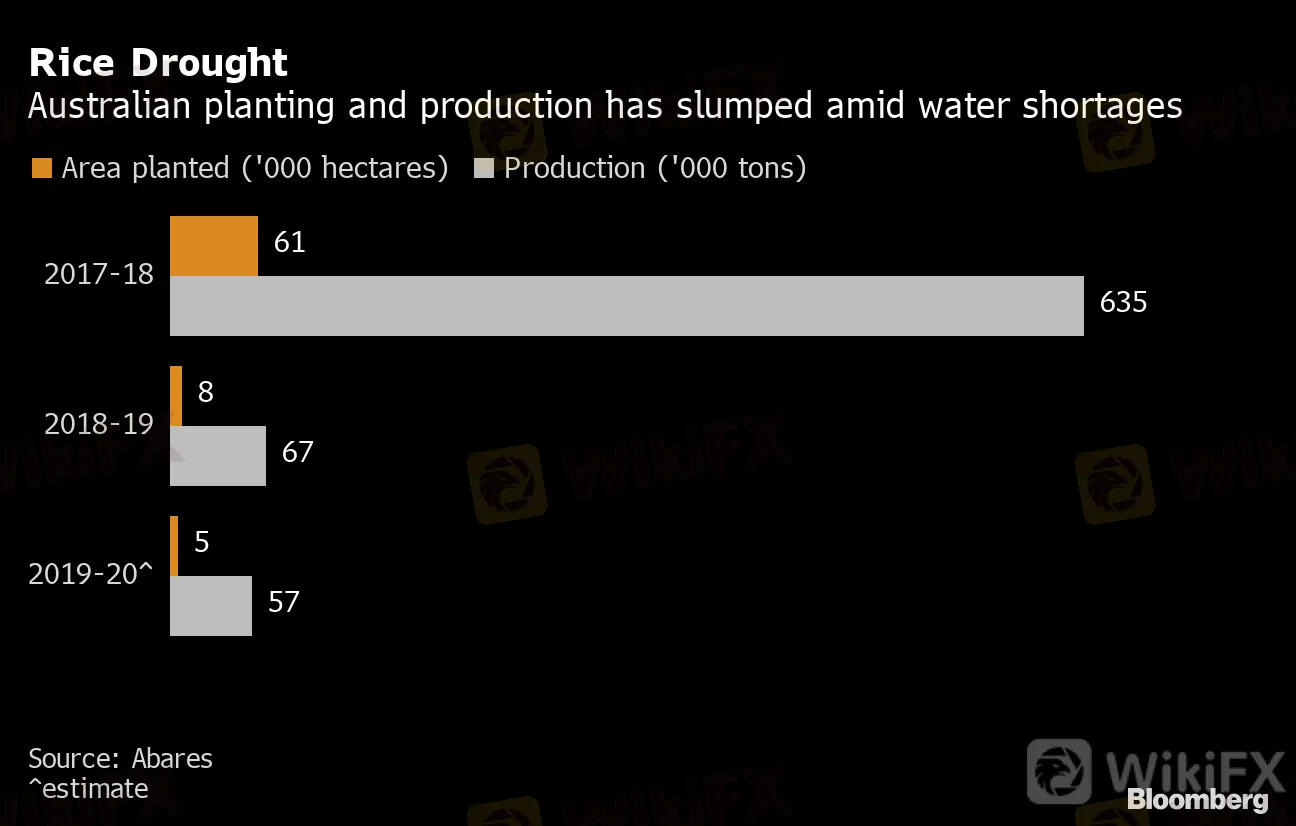简体中文
繁體中文
English
Pусский
日本語
ภาษาไทย
Tiếng Việt
Bahasa Indonesia
Español
हिन्दी
Filippiiniläinen
Français
Deutsch
Português
Türkçe
한국어
العربية
Drought Forces Australia to Import Rice or Risk Empty Shelves
Abstract:This season, like almost 90% of Australian rice growers, Rob Massina decided to skip planting the grain on his land near the tiny town of Jerilderie, about four hours north of Melbourne.
This season, like almost 90% of Australian rice growers, Rob Massina decided to skip planting the grain on his land near the tiny town of Jerilderie, about four hours north of Melbourne.
For the president of the Australian Ricegrowers Association, low water allocations and years of severe drought meant conditions were too dry to sow the crop on his property at the southern end of the Murray-Darling Basin.
“A lot of the towns in this part of the world have been built on rice,” said Massina. “It‘s a way of life for the southern Riverina and it’s currently got its challenges,” he said, referring to the name of the local region.
Australian rice planting and output have slumped more than 90% since the 2017-18 season. Its national 2019-20 crop is expected to be 57,000 tons, the second-smallest output on record and the lowest since the 2007-08, according to a June report from government forecaster Abares.
Read More: Australias Water is Vanishing
Though Australia has always been reliant on imports for certain varieties that cant be grown locally, like Basmati, its supermarkets may be entirely without local supplies by the end of 2020, according to Rob Gordon, chief executive of SunRice, which buys about 98% of domestic output and supplies local and export markets. The company has a global appetite for about 1.4 million tons a year, meaning Australian production is meeting only a sliver of that demand.
“We‘re already supplementing from Thailand and Cambodia,” Gordon said, for fragrant and long grain rice. “As we start running out of domestic supply of our other varieties, we’ll start opening up supply chains from elsewhere around the world. Were bringing in rice from Uruguay at the moment,” he said by phone.
Rice represents only a tiny fragment of Australias agriculture industry, and the country is a small player in global trade. However, shrinking supplies of locally grown rice were thrown into focus earlier this year when Covid-19 panic buying saw shoppers strip grocery shelves of everything from rice to flour and pasta.
Rice Drought
Australian planting and production has slumped amid water shortages
Source: Abares
^estimate

The government has reassured residents that their food supply is secure -- the country of 25 million produces enough food for 75 million and imports only 11% of food and drink by value -- but rice remains a gap in domestic production.
That could create issues amid global food protectionism as governments start trimming exports in order to shore up domestic supply, Gordon said.
“I believe strongly in international trade but of course during Covid, we saw in April the Vietnamese borders closed to rice exports and they are about the third-largest exporter of rice in the world. We saw India not shut its borders, but with a lockdown of its population they were unable to export large volumes of rice, and they are the biggest exporter. And we saw Cambodia and Myanmar follow Vietnams lead,” Gordon said. “It just puts more risk there.”
Water Policies
Gordon and Massina cite government water allocation policies in the Murray-Darling Basin as a key issue for the future security of production, with rice often less profitable than other crops and therefore less likely to be planted.
When water does become available, the first priority on his mixed-enterprise farm has to be the livestock, said Massina. For other producers, almonds and other horticultural products have taken priority over rice.
Government forecaster Abares said in June water allocations vary from year to year based on seasonal conditions and farmers can choose how to use them.
In May, Abares described Australian rice production as “highly variable and opportunistic,” based on agricultural prices and water availability, and said international trade is a good way to meet consumer preferences. Current low production is not a cause for food security concern, as the world has ample supplies and any protectionism is likely to be short-lived, it added.
Read More: Rice Giant Indias Exports to Rise as Drought Hits Thai Output
“Introducing domestic market interventions and failing to support open trade would disadvantage consumers, and could prejudice Australias market access negotiations for other agricultural products,” Abares said.
With early rainfall, prospects are better for the next growing season. Massina will later this year look at water availability and decide whether to plant a rice crop. Overall, he said the future of the Australian rice industry will depend “on whether Australian consumers want Australian rice on supermarket shelves.”
“Were getting down to the bottom of the cupboard in terms of Australian rice supplies,” he said.
Disclaimer:
The views in this article only represent the author's personal views, and do not constitute investment advice on this platform. This platform does not guarantee the accuracy, completeness and timeliness of the information in the article, and will not be liable for any loss caused by the use of or reliance on the information in the article.
WikiFX Broker
Latest News
Geopolitical Events: What They Are & Their Impact?
Volkswagen agrees deal to avoid Germany plant closures
Top 10 Trading Indicators Every Forex Trader Should Know
TradingView Launches Liquidity Analysis Tool DEX Screener
MultiBank Group Wins Big at Traders Fair Hong Kong 2024
WikiEXPO Global Expert Interview: Simone Martin—— Exploring Financial Regulation Change
'Young investors make investment decisions impulsively to keep up with current trends' FCA Reveals
Why Do You Feel Scared During Trade Execution?
CySEC Settles Compliance Case with Fxview Operator Charlgate Ltd
Malaysian Influencer Detained in Taiwan Over Alleged Role in Fraud Scheme
Currency Calculator


